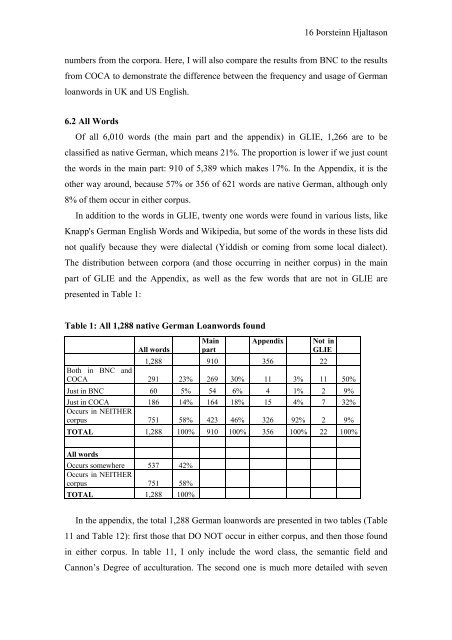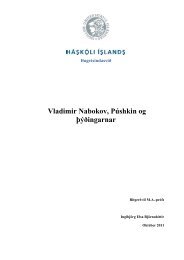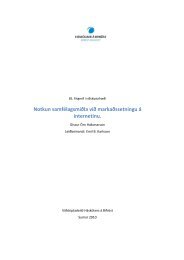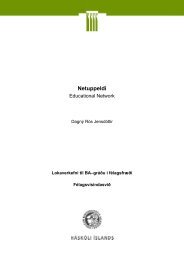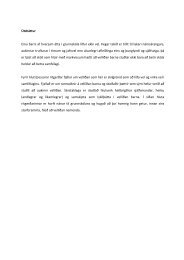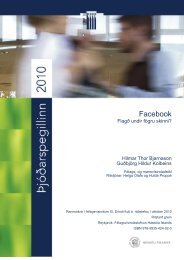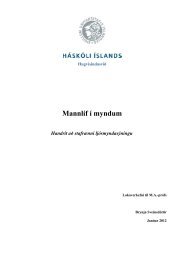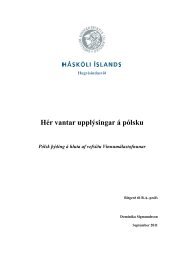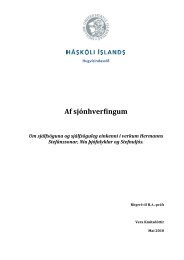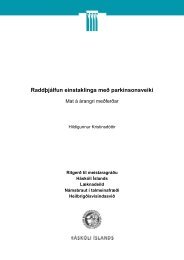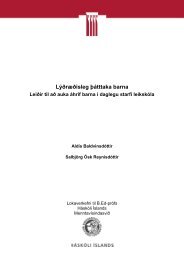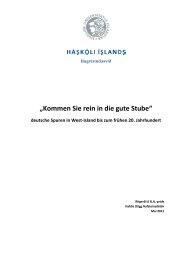Capturing the Zeitgeist Native German Loanwords in ... - Skemman
Capturing the Zeitgeist Native German Loanwords in ... - Skemman
Capturing the Zeitgeist Native German Loanwords in ... - Skemman
You also want an ePaper? Increase the reach of your titles
YUMPU automatically turns print PDFs into web optimized ePapers that Google loves.
16 Þorste<strong>in</strong>n Hjaltason<br />
numbers from <strong>the</strong> corpora. Here, I will also compare <strong>the</strong> results from BNC to <strong>the</strong> results<br />
from COCA to demonstrate <strong>the</strong> difference between <strong>the</strong> frequency and usage of <strong>German</strong><br />
loanwords <strong>in</strong> UK and US English.<br />
6.2 All Words<br />
Of all 6,010 words (<strong>the</strong> ma<strong>in</strong> part and <strong>the</strong> appendix) <strong>in</strong> GLIE, 1,266 are to be<br />
classified as native <strong>German</strong>, which means 21%. The proportion is lower if we just count<br />
<strong>the</strong> words <strong>in</strong> <strong>the</strong> ma<strong>in</strong> part: 910 of 5,389 which makes 17%. In <strong>the</strong> Appendix, it is <strong>the</strong><br />
o<strong>the</strong>r way around, because 57% or 356 of 621 words are native <strong>German</strong>, although only<br />
8% of <strong>the</strong>m occur <strong>in</strong> ei<strong>the</strong>r corpus.<br />
In addition to <strong>the</strong> words <strong>in</strong> GLIE, twenty one words were found <strong>in</strong> various lists, like<br />
Knapp's <strong>German</strong> English Words and Wikipedia, but some of <strong>the</strong> words <strong>in</strong> <strong>the</strong>se lists did<br />
not qualify because <strong>the</strong>y were dialectal (Yiddish or com<strong>in</strong>g from some local dialect).<br />
The distribution between corpora (and those occurr<strong>in</strong>g <strong>in</strong> nei<strong>the</strong>r corpus) <strong>in</strong> <strong>the</strong> ma<strong>in</strong><br />
part of GLIE and <strong>the</strong> Appendix, as well as <strong>the</strong> few words that are not <strong>in</strong> GLIE are<br />
presented <strong>in</strong> Table 1:<br />
Table 1: All 1,288 native <strong>German</strong> <strong>Loanwords</strong> found<br />
All words<br />
Ma<strong>in</strong><br />
part<br />
Appendix Not <strong>in</strong><br />
GLIE<br />
1,288 910 356 22<br />
Both <strong>in</strong> BNC and<br />
COCA 291 23% 269 30% 11 3% 11 50%<br />
Just <strong>in</strong> BNC 60 5% 54 6% 4 1% 2 9%<br />
Just <strong>in</strong> COCA<br />
Occurs <strong>in</strong> NEITHER<br />
186 14% 164 18% 15 4% 7 32%<br />
corpus 751 58% 423 46% 326 92% 2 9%<br />
TOTAL 1,288 100% 910 100% 356 100% 22 100%<br />
All words<br />
Occurs somewhere<br />
Occurs <strong>in</strong> NEITHER<br />
537 42%<br />
corpus 751 58%<br />
TOTAL 1,288 100%<br />
In <strong>the</strong> appendix, <strong>the</strong> total 1,288 <strong>German</strong> loanwords are presented <strong>in</strong> two tables (Table<br />
11 and Table 12): first those that DO NOT occur <strong>in</strong> ei<strong>the</strong>r corpus, and <strong>the</strong>n those found<br />
<strong>in</strong> ei<strong>the</strong>r corpus. In table 11, I only <strong>in</strong>clude <strong>the</strong> word class, <strong>the</strong> semantic field and<br />
Cannon’s Degree of acculturation. The second one is much more detailed with seven


